Product merchandising is the art of presenting products appealingly and strategically to increase their desirability and sales. Effective product merchandising can be the difference between a customer walking out of a store empty-handed or leaving with multiple items. It can also make a big difference in online sales and customer engagement.
This comprehensive guide explores the different types of product merchandising, provides examples of successful merchandising techniques, outlines steps to effective merchandising, and addresses challenges and solutions to keep your product merchandising strategy up-to-date.
Types of Product Merchandising
Visual Merchandising
Visual merchandising is an influential strategy in both physical retail and e-commerce, focused on creating aesthetically appealing displays to capture customer attention and drive engagement with products.
In e-commerce, visual merchandising incorporates website design elements such as layout, product imagery, and interactive features.
Recent research emphasizes the significant relationship between store layout, product display, and color & lighting with a consumer’s intention to purchase in online fashion retail. The findings suggest that these elements collectively enhance the attractiveness of an online store, thereby increasing consumer willingness to buy [1].
Additionally, the other study prioritized visual merchandising dimensions for online apparel retailers, highlighting “Pictorial Presentation” and “Product Information” as critical elements. This study provides a framework for fashion retailers to create more engaging and informative online stores, leading to increased sales [2].

Amazon's example of product layout
Furthermore, visual merchandising tools in both stationary and online stores influence customer loyalty. It was found that visual elements like lighting, colors, fonts, and the placement of goods significantly impact the buying process and consumer satisfaction, thereby fostering loyalty [3].
Digital Merchandising in Search
With the rise of online shopping, digital merchandising in search has become a critical part of product merchandising. Digital merchandising in search (also called searchandising) includes creating product listings, optimizing product images and descriptions, and utilizing data-driven practices to promote (or hide) certain products.
The goal of digital merchandising in search - is to make the customer’s online shopping experience as engaging and seamless as possible.

Amazon's product listing example
In-store Merchandising
In-store merchandising includes creating a welcoming and enjoyable shopping environment that encourages customers to purchase. It includes creating a store layout that makes it easy for customers to find products, strategically placing products, and using signage and displays to highlight promotions and new products. The arrangement and design of in-store displays are influential sales promotion tools [4].
Catalog Merchandising
Catalog merchandising is used to create visually appealing and easy-to-navigate product catalogs. Catalog merchandising includes choosing the right products to showcase, creating visually appealing product images, and organizing the catalog for customers to find what they’re looking for.

Example of Whole Foods market product layout
Effective design in catalogs, like in the Sephora or Whole Foods Market example, increases customer engagement [5].
Examples of Successful Product Merchandising
Apple Store.
The Apple Store is one of the most successful examples of visual merchandising. The store’s minimalistic design, clean lines, and white space create a calming and inviting environment that encourages customers to engage with the products.
The use of displays that allow customers to interact with the products is also a key part of Apple’s visual merchandising strategy.

Nike Store.
The Nike store is an example of successful in-store merchandising. The store’s use of digital displays, mannequins, and product placement creates an immersive shopping experience that encourages customers to engage with the products.
The store’s layout is also designed to make it easy for customers to find products and navigate the store.

Sephora.
Sephora is an example of successful catalog merchandising. Sephora’s catalogs feature visually appealing product images, easy-to-read descriptions, and a layout that makes it easy for customers to find the needed products. The catalogs also include information on new products and promotions, encouraging customers to buy.

Amazon.
Amazon is an example of successful digital merchandising. Amazon’s product listings include high-quality product images, detailed descriptions, and customer reviews. Personalized recommendations and targeted email marketing also make the online shopping experience engaging and seamless.

Steps to Effective Product Merchandising
1. Understanding the target audience
To effectively merchandise products, it’s critical to understand who the target audience is and what they’re looking for. It includes understanding their demographics, shopping behavior, and preferences. It is also crucial for tailoring the merchandising strategy [6].
2. Designing the store layout
The store layout should be designed in a way that makes it easy for customers to find products and encourages them to explore the store. It includes creating clear pathways, placing products in strategic locations, and using signage and displays to highlight promotions and new products. All these elements influence customer exploration and purchasing decisions.
3. Creating a cohesive visual theme
Visual merchandising is a key part of effective product merchandising. Creating a cohesive visual theme can help create a memorable and engaging shopping experience. It includes using color schemes, textures, and lighting to create a specific ambiance that reflects the brand and appeals to the target audience.
4. Organizing and grouping products strategically
Grouping products can help increase sales by encouraging customers to make multiple purchases. It can include creating product collections, placing complementary products together, and using product placement to highlight specific items. Grouping and placement affect sales [7].
5. Optimizing pricing and promotions
Pricing and special deals can drastically impact sales. It’s essential to price products competitively and offer promotions that appeal to the target audience. It includes using discounts, bundle deals, and loyalty programs to encourage repeat purchases.
Challenges and Solutions
Effective product merchandising requires staying up-to-date with changing consumer behavior and preferences.
Some challenges that can arise include inventory management, changes in consumer behavior, and staying up-to-date with technology and trends. It requires ongoing day-to-day market research and analysis.
Inventory management challenges
Inventory management can be challenging, especially for retailers with a large number of products. Utilizing inventory management software and tracking inventory levels can help ensure that popular products are in stock and excess inventory is minimized.
Changes in consumer behavior and preferences
Consumer behavior and preferences are constantly changing, and it’s critical to stay up-to-date with these changes to effectively merchandise products. It can include utilizing market research, analyzing sales data, and keeping up-to-date with industry trends.
Staying up-to-date with technology and trends
Technology and trends are constantly evolving, and it’s essential and crucial to stay up-to-date with these changes to remain competitive. It can include utilizing social media and digital marketing, implementing new technologies such as augmented and virtual reality, and offering mobile-friendly shopping experiences [8].
By understanding different merchandising types and implementing data-driven strategies, businesses can enhance customer experiences and drive sales. Staying informed about consumer behavior and technological trends is key to successful merchandising.
References
Mondol, E., Salman, N., Rahid, A., & Karim, A. (2021). The Effects of Visual Merchandising on Consumer’s Willingness to Purchase in the Fashion Retail Stores. International Journal of Academic Research in Business and Social Sciences. https://doi.org/10.6007/ijarbss/v11-i7/10469.
Jakhar, R., Verma, D., Rathore, A., & Kumar, D. (2020). Prioritization of dimensions of visual merchandising for apparel retailers using FAHP. Benchmarking: An International Journal, 27, 2759-2784. https://doi.org/10.1108/bij-11-2019-0497.
Seleznova, O., Rudinska, O., & Kusyk, N. (2020). The Influence of Visual Merchandising on the Formation of Customer Loyalty. , 4, 44-54. https://doi.org/10.15276/mdt.4.3.2020.5.
Said, Y., Bragazzi, N., & Pyatigorskaya, N. (2019). Influence of Sales Promotion Techniques on Consumers’ Purchasing Decisions at Community Pharmacies. Pharmacy: Journal of Pharmacy Education and Practice, 7. https://doi.org/10.3390/pharmacy7040150.
Caliva, E., Salera, M., Tajonera, A., Tan, A., & Sedilla, K. (2019). Affective Design of Store Window Displays for Selected Philippine Retail Brands: Guidelines for an Affective Visual Merchandising. , 349-357. https://doi.org/10.1007/978-3-030-20441-9_37.
Berkhout, C. (2019). Ways of Organising Assortment. Assortment and Merchandising Strategy. https://doi.org/10.1007/978-3-030-11163-2_4.
Cuong, P. (2019). Antecedents of Store Management Strategies and Visual Merchandising on the In-Store Engagement of Consumer Good Buyers: An Empirical Study. , 24, 76-89. https://doi.org/10.17549/gbfr.2019.24.4.76.
Kaur, J., Arora, V., & Bali, S. (2020). Influence of technological advances and change in marketing strategies using analytics in retail industry. International Journal of System Assurance Engineering and Management, 11, 953 - 961. https://doi.org/10.1007/s13198-020-01023-5.